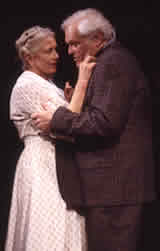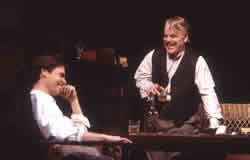 The
Poison Talking
The
Poison Talking
By Una Chaudhuri
Long Day's Journey Into Night
By Eugene O'Neill
Plymouth Theater
236 W. 45th St.
Box office: (212) 239-6200
They're back. And they're at it again.
America's First Family, the everlasting Tyrones, back in their
summer cottage on the beach, back to face the grim music of their
disappointments and despair, and back also to challenge us to
account for ourselves, our hopes and dreams, our betrayals and
breakdowns. In the masterful revival of Long Day's Journey
Into Night at the Plymouth Theatre, the appalling difficulty
of the play yields a rare theatrical experience, four hours of
self-disclosure of an intensity that renders the distinction between
actor and character altogether academic. Under Robert Falls's
sure direction, Vanessa Redgrave, Brian Dennehy, Phillip Seymour
Hoffman, Robert Sean Leonard and Fiana Toibin, give performances
of historic caliber and consequence, laying bare a new layer of
this play's endless insights into the American cultural imaginary.
As the country embarks on a possibly disastrous political journey,
this mother of all American plays speaks of the limits--even the
pathology--of self-involvement.
The main insight of O'Neill's play is the
idea that hell is not just--as Sartre famously had it--"other
people": it is other people to whom one is tied with bonds of
blood and biography. Hell is family. Hell is that welter of indestructible
memories and stone-etched resentments, the ceaselessly repeated
exchanges of anger, sorrow, need, disappointment, frustration,
and shame that is the dark language of kinship. "Written in blood,"
as O'Neill himself described it, Long Day's Journey Into Night
was also written in that first, horror-stricken understanding,
given by psychoanalysis, of the explosive tensions and crippling
toxicity of what later came to be called, without irony, the nuclear
family. With its unflinching ear for the cruel insinuations and
shocking outbursts of family talk, Long Day's Journey
towers above such later classics of the genre as Pinter's The
Homecoming and Shepard's Buried Child by virtue
of its painful and patently autobiographical honesty. This day
in the life of an aging couple and their two sons lays bare the
author's own struggle to wrest creativity from family pathology,
art from illness, truth from failure.
The power of the play, it has often been
said, is largely due to its intense inward focus: although the
text states that the action occurs in 1912, the play does nothing
to bring that action into relation with any public events of those
tumultuous times, nor of those (including a world war) in which
the play was written, 1939-40. The Tyrones seem a world unto themselves,
hermetically sealed off from everything else.
And yet a keen awareness of the larger
world was one reason O'Neill gave for imposing the notorious twenty-five-year
posthumous ban on publication of the of the play (and unlimited
ban on production): while often remarking that this was the finest
thing he had ever written, he added that it was not a work he
wanted to bring to the world "in this crisis-preoccupied time."
His wife and executor, Carlotta, did not honor these requests.
The play was published three years after O'Neill's death and premiered
the same year, 1956, in Stockholm, Sweden. The young director
of that production, Bengt Ekerot, regarded the play as the definitive
accomplishment of the Ibsenite-Chekhovian paradigm of psychological
realism, in which everything emanated from impulses deep within
the characters, nothing from the world around them. By contrast,
the first--and now legendary--American production, directed by
Jose Quintero, set the emotional mass of the family's interactions
within a larger framework suggested by the play's diurnal structure
as well as its major symbolic image: the fog. Quintero asked for
a design that would "bring nature into the set" and show the characters'
journey in relation to "the various speeds and moves that the
sun experiences as it makes its long voyage across the sky." David
Hays, the designer, responded with a set built around three large
windows, through which the play's powerful non-human actors--the
sun, sea, and fog--entered to shape the family drama into a tragedy
of radical non-belonging.
In the half-century since those premieres,
the play has become a monument of both psychological realism and
poetic symbolism. The forms of behavior and rhythms of speech
that constitute the family's pathology have been brilliantly observed
to the point of clinical diagnosis. At the same time, the halting
lyricism of the young poet's self-accounting--"stammering is the
native eloquence of us fog people," says the character Edmund--is
matched by a paradoxical landscape of open sea and enclosing fog,
the romance of the one contrasting bitterly with the carceral
effects of the other. In the acclaimed 1988 Stockholm production
directed by Ingmar Bergman (which visited BAM in 1991), the impact
of environment on the inner life of the characters was literalized
through the expressionist device of still images projected behind
the stage: the facade of the house, a closed door, the fog enshrouded
house, at the end a radiant tree. Bergman also disrupted O'Neill's
insistent unity of place by setting the last act on the verandah
of the cottage, placing Edmund closer to the outside world. Few
productions have pushed the play toward a more specific social
context, although European ones have frequently looked for the
characters' universal humanity through an understanding
of their American context. The director of the first Italian production
(Milan, 1956) asked if "anyone who looks closely at Edmund and
James" would not be reminded of "the two sons of Willy Loman,
Miller's traveling salesman? Their fall/failure takes place on
the same terrain."
 Willy
Loman might easily come to mind in the widely acclaimed production
currently on Broadway, if only because Death of a Salesman
was the last, and hugely successful, collaboration between the
play's director Robert Falls and one of its stars, Brian Dennehy.
Dennehy indeed brings a kind of white-collar pathos to the role
of James Tyrone, highlighting the money-anxieties of the potato-famine
Irish immigrant over the bluster of the bardolatrous actor. His
petty self-delusions are no match for his wife's titanic regrets,
which inexorably drag the men around her into the depths of despair.
As played by Vanessa Redgrave, Mary Tyrone dominates this excavation
of O'Neill's subterranean labyrinth of regret and recrimination.
Her performance is so detailed and so riveting that it changes
the basic question of the play, the one rooted in its retrogressive
action: why is she so hurt, angry, damaged? Watching Redgrave
go from flirtatious playfulness to sadistic sarcasm to terrifying
attack and finally back to childlike innocence, one finds her
husband's explanation--"it's the poison talking"--utterly unsatisfying.
Watching her flutter and start and fidget and--in one heartbreaking
moment--literally climb the walls, one wonders: what is the poison
really saying?
Willy
Loman might easily come to mind in the widely acclaimed production
currently on Broadway, if only because Death of a Salesman
was the last, and hugely successful, collaboration between the
play's director Robert Falls and one of its stars, Brian Dennehy.
Dennehy indeed brings a kind of white-collar pathos to the role
of James Tyrone, highlighting the money-anxieties of the potato-famine
Irish immigrant over the bluster of the bardolatrous actor. His
petty self-delusions are no match for his wife's titanic regrets,
which inexorably drag the men around her into the depths of despair.
As played by Vanessa Redgrave, Mary Tyrone dominates this excavation
of O'Neill's subterranean labyrinth of regret and recrimination.
Her performance is so detailed and so riveting that it changes
the basic question of the play, the one rooted in its retrogressive
action: why is she so hurt, angry, damaged? Watching Redgrave
go from flirtatious playfulness to sadistic sarcasm to terrifying
attack and finally back to childlike innocence, one finds her
husband's explanation--"it's the poison talking"--utterly unsatisfying.
Watching her flutter and start and fidget and--in one heartbreaking
moment--literally climb the walls, one wonders: what is the poison
really saying?
What is this masterpiece of American drama
saying at this "crisis-preoccupied time," so different
from the one in which it was conceived? Are those elusive forms--modern
tragedy, American tragedy--more possible in the aftermath
of our recent horrors, and can O'Neill's family saga be a resonant
echo chamber for the nation's sorrow? The set of this production,
designed by Santo Loquasto, suggests something of the trajectory
the meanings must now follow. The set tells a story of radical
otherness, framing the anguished subjectivity of the
characters within an immense and eloquent objectivity. The stage
is dominated by a vast expanse of dark wood, the walls of the
Tyrone family house stretching endlessly upward. The naturalistic
living room, neither cozy nor cold, neither shabby nor elegant,
lies low to the ground, weighed down by the mass of darkness rising
above it. As they tower above the anguished action of the play,
these mammoth walls signify ceaselessly: they are the walls of
a tomb, the hull of a ghost ship, the trunk of a gigantic tree.
Over time (and of course it is a long, long time, over
four hours) they become the overarching and inflexible contours
of the human condition, simultaneously amplifying and dwarfing
the anguish of the frail creatures beneath them. Under their impassivity,
the Tyrones's self-analysis, pathologically rigorous as it is,
is revealed as inadequate to the complex challenge of living maturely
in the real world.
Edmund laments that he was born a man:
"I would have been more successful as a sea gull or a fish." Invoking
the non-human world of mute creatures and silent things, the poet
longs for an alternative to the destructive "talking" of the poisoned
self. Although this production eschews a transcendence of the
kind signified by Berman's radiant tree, its courageous pursuit
of everything that lies beneath the "talking" brings another kind
of resolution into view: the exhaustion of inwardness and the
turn to the outside world, with hope and humility.
